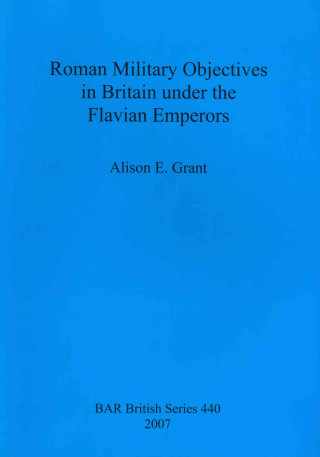
Kód: 12063260
Roman Military Objectives in Britain under the Flavian Emperors
Autor Alison E. Grant
Since archaeology is an ongoing process, archaeological discoveries must repeatedly be reassessed in terms of a constantly developing historical context. This study attempts to do that, and, particularly, to reconcile the up-to-da ... celý popis
- Jazyk:
 Angličtina
Angličtina - Väzba: Brožovaná
- Počet strán: 207
Nakladateľ: BAR Publishing, 2007
- Viac informácií o knihe

Mohlo by sa vám tiež páčiť
-

University Park and South Denver
9.31 € -2 % -

Compendium of American Genealogy
124.62 € -

Cultures of Violence
139.57 € -

More Sex Is Safer Sex: The Unconventional Wisdom of Economics
17.40 € -5 % -

The Silver Linings Playbook
38.09 € -

Pink Cat Blue Cat
19.45 € -

Three Hearts and Three Lions
68.91 €
Darčekový poukaz: Radosť zaručená
- Darujte poukaz v ľubovoľnej hodnote, a my sa postaráme o zvyšok.
- Poukaz sa vzťahuje na všetky produkty v našej ponuke.
- Elektronický poukaz si vytlačíte z e-mailu a môžete ho ihneď darovať.
- Platnosť poukazu je 12 mesiacov od dátumu vystavenia.
Viac informácií o knihe Roman Military Objectives in Britain under the Flavian Emperors
Nákupom získate 253 bodov
 Anotácia knihy
Anotácia knihy
Since archaeology is an ongoing process, archaeological discoveries must repeatedly be reassessed in terms of a constantly developing historical context. This study attempts to do that, and, particularly, to reconcile the up-to-date archaeological record with existing documentary sources. The Prologue shows how traditional and contemporary approaches to the study of Roman military history in Britain have shaped accounts of the Flavian period (AD 69-96). It summarises fact and fiction regarding the achievements of Agricola's seven-year governorship (AD 77-83), and demonstrates how recent discoveries are now beginning to present a new picture of first-century campaigning in northern Britain. It also introduces the documentary sources, especially the place-names and tribal areas on 'Ptolemy's Map', the place-names in the British section of the Ravenna Cosmography, and the text of Tacitus' Life of Agricola, which are used to examine the military zone (north of a line roughly from Bristol to Lincoln). Part I deals with the political and geographical structure of Britain - as far as possible from the native standpoint. Chapter 2 presents and discusses identifications for each place-name in the Ravenna list and advocates an accurate, 'regional' distribution of names. Chapter 3 builds upon this, by using the place-names, together with the information from Ptolemy's map and other classical sources, to determine the tribal areas, which are vital for understanding the situation that the Romans encountered. Part II superimposes the historical narrative; it shows how Tacitus' account does indeed fit well with the geopolitical infrastructure of Britain, highlights the remarkably close correspondence between documentary sources and archaeological discoveries, and produces a greatly enhanced understanding of the Roman campaigns within northern Britain during the first century. However, the original Ravenna document was compiled no earlier than the second century, because it includes place-names associated with both Hadrian's Wall and the Antonine Wall. The Epilogue looks at the dating issue, suggests a date c.142-3, and shows how the place-names can be used to explain the reasons behind the reorganisation of northern Britain and the renewed advance into Scotland as far as the Tay, which took place in the early years of the reign of Antoninus Pius (AD 138-61).
 Parametre knihy
Parametre knihy
Zaradenie knihy Knihy po anglicky Humanities Archaeology Archaeology by period / region
102.40 €
- Celý názov: Roman Military Objectives in Britain under the Flavian Emperors
- Autor: Alison E. Grant
- Jazyk:
 Angličtina
Angličtina - Väzba: Brožovaná
- Počet strán: 207
- EAN: 9781407301143
- ISBN: 1407301144
- ID: 12063260
- Nakladateľ: BAR Publishing
- Hmotnosť: 726 g
- Rozmery: 297 × 210 × 13 mm
- Dátum vydania: 15. August 2007
Obľúbené z iného súdka
-

Lifeways of Hunter-Gatherers
34.40 € -16 % -

Lost Technologies of Ancient Egypt
22.21 € -15 % -

Magicians of the Gods
15.04 € -11 % -
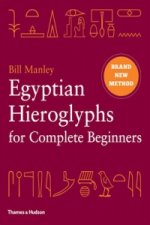
Egyptian Hieroglyphs for Complete Beginners
16.48 € -12 % -

Horse, the Wheel, and Language
30.30 € -4 % -

War before Civilization
23.75 € -

Petra
9 € -23 % -

Cat in Ancient Egypt
12.28 € -23 % -

Complete Pompeii
22.01 € -23 % -
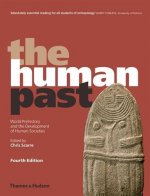
Human Past
71.57 € -

Scenes from Prehistoric Life
27.44 € -23 % -

Across Atlantic Ice
44.43 € -

Book of Enoch
34.60 € -4 % -

Timewalkers
20.78 € -

Creating the Human Past
42.39 € -

Resurfacing the Submerged Past
74.75 € -

Mesolithic Europe
154.32 € -
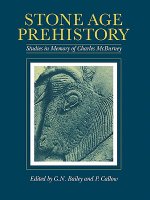
Stone Age Prehistory
53.04 € -

Her Cup for Sweet Cacao
67.58 € -10 % -

Lindow Man
16.27 € -

American Beginnings
93.28 € -

Against the Grain
20.16 € -13 % -

Dress Accessories, c. 1150- c. 1450
36.34 € -14 % -

Rise of Bronze Age Society
86.22 € -

Lewis Chessmen: Unmasked
10.03 € -14 % -

Neanderthals Among Mammoths
209.93 € -

Biblical Archaeology: A Very Short Introduction
10.13 € -22 % -

Bible Unearthed
21.90 € -

Seismosaurus
116.12 € -

Treasures of the Valley of the Kings
33.27 € -8 % -

Divine Creatures
25.90 € -1 % -

Tutankhamun
32.76 € -23 % -

Hieroglyphics
29.89 € -5 % -

First Artists
21.90 € -23 % -

In Search of the Indo-Europeans
31.43 € -12 % -

Performance Power and the Art of the Aegean Bronze Age
62.56 € -

Tasting the Past
27.23 € -5 % -

Classical Archaeology 2e
43.82 € -4 % -

Upper Pleistocene Prehistory of Western Eurasia
89.29 € -

Humans at the End of the Ice Age
214.64 € -

Medieval European Coinage: Volume 14, South Italy, Sicily, Sardinia
98.92 € -

Prehistory: A Very Short Introduction
11.56 € -12 % -
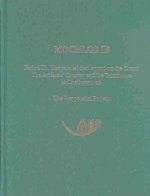
Mochlos IB
129.54 € -

Salt in Prehistoric Europe
37.68 € -

Prehistoric Rock Art
34.60 € -15 % -

Medieval Household
58.77 € -3 % -

Complete Cities of Ancient Egypt
30.92 € -13 % -

First Signs
16.17 € -21 % -

Mesolithic Europe
75.46 €
Osobný odber Bratislava a 2642 dalších
Copyright ©2008-24 najlacnejsie-knihy.sk Všetky práva vyhradenéSúkromieCookies



 21 miliónov titulov
21 miliónov titulov Vrátenie do mesiaca
Vrátenie do mesiaca 02/210 210 99 (8-15.30h)
02/210 210 99 (8-15.30h)